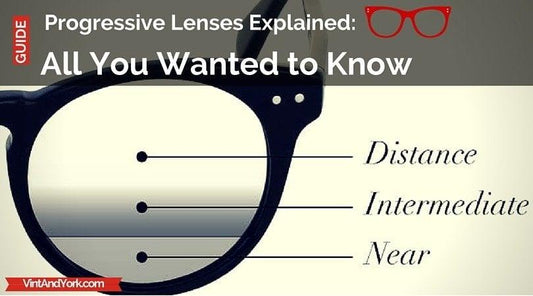So it’s finally time for new glasses! Great news! Except for the fact that you’re still doubting what size of glasses is the right one for you. No need to worry, as this is one of the most common questions we get at Vint & York – and we’d love to help you with it in this guide.
Whether you’re looking to purchase your first pair of frames or you’re already wearing eyeglasses for quite some time, this guide is here to help you choose the correct frame for your face. We’ll show you how to measure your face for glasses frames and what each size means, so you can shop easily.
Understanding Eyeglasses Measurement & What They Mean
Before looking at styles like cat-eye or aviators, you need to first know what size you need. Luckily, every pair of eyeglasses frames has a series of tiny numbers printed on the inside of the glasses’ temples, though some may be displayed on the earpiece or the bridge of your nose.
On Vint & York’s glasses, measurements can be found printed on the inside of the temple arm – and you can also find them on the product pages.
These numbers show you the size of your glasses: the lens width, the bridge width, and the length of the frame arms, all measured in millimeters.
- The first 2-digit figure represents the lens diameter, usually between 31-60mm
- The second 2-digit figure represents the bridge width, usually between 12-31mm
- The third 3-digit figure measures the length of your frame arms, usually between 115-155mmm
When you look for glasses online you’ll see that the frame size is typically noted with these 3 numbers as lens width – bridge width – frame arm length. At Vint & York frame measurements you will find for example 45-15-130.

Lens Width
The lens diameter is the width of the lens measured from the bridge. The size of your lenses can be a matter of personal choice, but it’s also determined by your frame style and prescription.
Bridge Width
The bridge width is the gap above your nose between the lenses. This must be comfortable because if it’s too tight the glasses could pinch your nose, and if it’s too loose the glasses won’t be stable on your face.
Frame Length
And last but not least, the length of your frame should be long enough to sit comfortably over your ears.
These are the key measurements that describe the structural measurements of the frames in eyeglasses and help the optician choose the best-fitted frame for your head size and facial features. The next thing is finding out what will be the measurements that you need – you can do this by either measuring a pair you already have or starting from scratch and measuring your face – we’ll take you through both methods in the next sections:
Find out Your Glasses Size by Measuring A Pair You Already Own
A simple way to find out what eyeglasses size you need is to look at other pairs of frames you already own – even sunglasses. If you feel they fit your face well and are comfortable, just use those measurements, and based on those, see in what category they fit – whether small, medium, or wide.
No sizes inside the arm?
If you do not see a clear series of measurements along with the inside temple, you can measure your current pair by yourself, following these steps:
- Measure horizontally the entire front of the frame width with a ruler. Put the edge of your ruler over your frame and measure from the left hinge to the right hinge. Include any lug or hinge pieces that stick out on the sides.
- Measure the temple length. Place your ruler at the hinge, where the arms connect in the front and measure straight across to the spot where the arm begins to bend down around the ear.
- The bridge width: measure horizontally, at the top of the bridge, from the edge of one lens to the other.
- Find the lens width by measuring the lenses horizontally, from the farthest point on the edge to the other


TIP: To feel perfectly comfortable and not feel your glasses tighten, there should be a gap between the arm of the glasses and your temple, but only a very small gap.
If you have had problems with temples being too short, look for frames with a length of 145-150mm. Acetate temples can be adjusted to get the best fit but it is important to have enough length so the temple sits horizontally and does not tip up over the ear.
So, if you already have a pair that you like, you can compare measurements to see how a certain frame of ours will fit you.
If you don’t think your glasses are the right size, and you want to make a more professional measurement go to the next section on how to measure your face for glasses.
How to Measure Your Face for Glasses
If you’re not quite sure what size your face is, don’t worry. The process of measuring your face is easier than it seems.

Here are the 4 steps to look for to measure your face for glasses frames:
- Measure temple to temple using a ruler or a flexible tape measure that stretches easily across your face. Place the tape measure flat against your face
- Start with your forehead. Measure it at the widest point, from hairline to hairline, and write down the measurements.
- Measure your jawline at the widest point, which is about 1 inch (2.5 cm) down from your ears.
- Find your face width by choosing the larger number out of the two measurements you just took (forehead width and jawline width).
Once you have your face width, next you need to compare it with the total frame size, which is summed up by adding the lens width x 2 + bridge width.
The total width of your glasses (both lens frames + bridge) should correspond as closely as possible to your temple-to-temple measurement.
For example, if your temple-to-temple width is 132 millimeters, then you should look for a pair of glasses with a width in the 130–134 millimeters range.
As a general guideline, here are some starting points for your face width :
- 125mm – 129mm face width match with Small/Narrow fit frames
- Medium Face: 130mm – 134mm face width match Medium fit frames
- Wide Face: 135mm – 140m face width match Wide fit frames
After you have all these measurements it will be easier to find glasses by size and look for pairs in your category. At Vint & York, the glasses size range is divided into 3 categories: narrow, medium, and wide.
Shop our best frames for small/narrow faces




Shop of our best frames for medium faces




Shop of our best frames for wide faces




Bear in mind that the temples should be adjusted to fit around your ears. If you have a problem with glasses sliding down your nose, you need to have the temples bent to keep them in place.
Of course, these measurements can also bring some insight into discovering your face shape. By knowing everything about your face, you’ll be able to find the perfect glasses style for your face shape that compliments your appearance and adds more personality to your look.
Measure Your Pupillary distance
While searching for the correct glasses size, make sure you also select the right size according to your pupillary distance and temple width.
In case you don’t know your PD, we will use an average PD, or you can head on to our guide on how to measure your PD online which describes how to measure your PD using a simple credit card. We can also measure your PD at the end of the checkout with a special app.
Measure the Nose Bridge for Glasses
One of the important things in finding the perfect pair of glasses is to measure your nose bridge – the part of the frame that sits just above (or on) your nose. A too-tight bridge will pinch at the nose and cause the frame to sit too high, while a too-large bridge will keep your glasses sliding down your face all day long.
The bridge measurement is the distance between the inside of one lens to the other. To measure it look in the mirror to see where your nose bridge starts and how wide or narrow your nose is. If your eyes are close together, then your nose tends to be narrow, and if your eyes are further apart, then your nose tends to be wide.
TIP: One helpful trick is to take a selfie of your side profile.
If your bridge is below or at the level of your pupils, it’s safe to say that you have a low bridge size and you should look for bridges in the 16–18 millimeters range.
On the other hand, if your bridge is above your pupils or it is wider than average, your bridge size will be larger and you should look for a bridge in the 19–21 millimeters range.

How Should Your Glasses Fit on Your Face?
Here are some helpful tips on how to know if your glasses are the right size for you:
- The width of the frame should match approximately the width of your face. This means the glasses should not hang off the side of your face, and also you shouldn’t be able to see the sides of the temples.
- They should not cover your eyebrows. This means you should be able to see your eyebrows above the frames when looking in the mirror. At least half of them.
- The temples should be adjusted to fit around your ears. If you have a problem with glasses sliding down your nose, you need to have the temples bent to keep them in place.
- They shouldn’t touch your cheeks. If your frame sits too tight against the apples of your cheeks when smiling, it needs to be adjusted to sit higher.
- A properly fit pair of glasses sit slightly against your skin, and won’t leave a mark on the side of your forehead.
Find the Perfect Glasses Size at Vint & York
Searching for a pair of glasses that’s not too loose and not too tight?
We at Vint & York created a beautiful range of glasses frames that accommodate all face widths, no matter if it’s narrow , medium , or wide . Our goal is to help you find the right-fitting pair that doesn’t slide off your face or detract from your personal style.
At Vint & York, the perfect fit is just a virtual try-on away. You can check out how you look with our Virtual try-on app , no matter what kind of glasses you need we’ll help you make your decision.
We offer free returns and a one-year limited frame warranty, so there’s no risk whatsoever if the glasses you buy don’t feel right.












